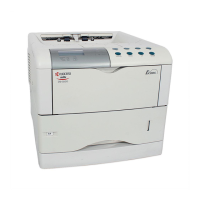4-32
FS-1800/1800N | FS-3800/3800N
As change in temperature is detected by the thermistor, CPU U201 adjusts the voltage that is
resultant of change in temperature, given at pin #3 (THERM) to keep the temperature as constant as
possible. This voltage is used to continuously switch the fuser lamp on and off. If pin #4 (HEATON)
of the engine gate array U204 is H level, transistor Q204 (pin #2) turns on, the photo coupler (PC)
on the power supply unit turns on, and the triac (TRC) turns on, consequently the heater lamp is AC
powered and lights. The heater lamp continuously turns on and off to maintain the temperature on
the heater roller at approximately 185
*1
/200
*2
°C (Normal paper, A4), 175
*1
/190
*2
°C (Thin paper,
A4), and 190
*1
/205
*2
°C (Thick paper, A4) for printing and approximately 95 °C at standby (Ready).
Refer to section Fusing on page 4-15.
*1
: FS-1800/1800N
*2
: FS-3800/3800N
Abnormal temperature detection circuit
The thermal cutout device which is connected in series with the heater lamp, constitutes the the
abnormal temperature detection circuit including of comparators U205-2, R217, R219, etc. Pin #5
of the comparator U205-2 is continuously given with the voltage by resistors R217 and R219,
which simulate the voltage given if an abnormally high temperature develops. Pin #6 receives the
voltage the thermistor detects. For instance, the heater lamp happens not to switch off, the voltage
the thermistor gives at pin #6 will become unusually high, and as soon as it exceeds the voltage at
pin #5, pin #7 of the comparator U205-2 output changes to L level. This in turn turns transistors
QA201B and QA201A on, and turns QA201A (pin #6) to L level. Since pins #6 of the transistor
QA201A and #2 of transistor Q204 are connected to each other, pin #4 of the engine gate array
U204, even though it is currently at H level, is enforced to be H level, effectively disabling the
heater lamp. Pin #7, the output from comparator U205-2, changes to L. Then, it is output to #63 of
CPU (U201) which in turn determines that an unusual temperature has developed in the fuser,
indicating Call service personE4.
Thermistor blown-out detection
The thermistor is monitored by the combination of comparator U205-1, R233, and R238. Extremely
low potential is applied to pin #3 of U205-1 by means of R233 and R238. Whereas, pin #2 is
applied with the voltage the thermistor detects. In normal state, as the heater lamp glows, the voltage
detected by the thermistor is greater than the potential at #3 of U205-1, making the U205-1 output
to L and sent to #54 (THDEAD) of CPU.
When the thermistor has blown, pin #2 of U205-1 becomes zero which is well lower than the
potential at pin #3 of U205-1, the comparator output becomes H, delivering THDEAD at pin #54 of
CPU. CPU uses this signal to determine that the thermistor is faulty and displays Call service
personE4.

